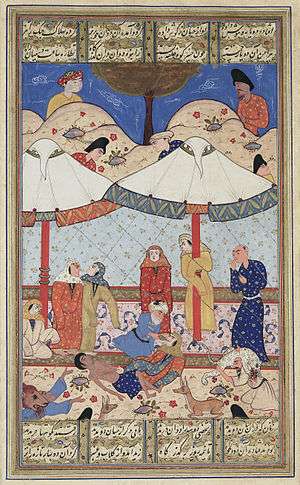Layla and Majnun
Majnun Layla (Arabic: مجنون ليلى Majnūn Laylā, 'Layla's Mad Lover';[1] Persian: لیلی و مجنون Leyli o Majnun) is an old story of Arabic origin,[2][3] about the 7th-century Najdi Bedouin poet Qays ibn al-Mullawah and his ladylove Layla bint Mahdi (or Layla al-Aamiriya).[4] "The Layla-Majnun theme passed from Arabic to Persian, Turkish, and Indian languages",[5] most famously through the narrative poem composed in 584/1188 by the Persian poet Nizami Ganjavi, as the third part of his Khamsa.[4][6][7][8][lower-alpha 1] It is a popular poem praising their love story.[9][10][11] Lord Byron called it "the Romeo and Juliet of the East."[12]
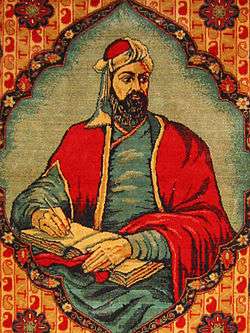 |
| Part of a series on |
| Nizami Ganjavi |
|---|
| The Khamsa or Panj Ganj |
| Related topics |
| Monuments |
|
Nizami Mausoleum • Nizami Museum of Azerbaijani Literature • Nizami Gəncəvi (Baku Metro) • in Ganja • in Baku • in Beijing • in Chișinău • in Rome • in Saint Petersburg • in Tashkent |
Qays and Layla fall in love with each other when they are young, but when they grow up Layla's father doesn't allow them to be together. Qays becomes obsessed with her, and his tribe Banu 'Amir and the community gives him the epithet of Majnūn (مجنون "crazy", lit. "possessed by Jinn"). Long before Nizami, the legend circulated in anecdotal forms in Iranian akhbar. The early anecdotes and oral reports about Majnun are documented in Kitab al-Aghani and Ibn Qutaybah's Al-Shi'r wa-l-Shu'ara'. The anecdotes are mostly very short, only loosely connected, and show little or no plot development. Nizami collected both secular and mystical sources about Majnun and portrayed a vivid picture of the famous lovers.[13] Subsequently, many other Persian poets imitated him and wrote their own versions of the romance.[13] Nizami drew influence from Udhrite love poetry, which is characterized by erotic abandon and attraction to the beloved, often by means of an unfulfillable longing.[14]
Many imitations have been contrived of Nizami's work, several of which are original literary works in their own right, including Amir Khusrow Dehlavi's Majnun o Leyli (completed in 1299), and Jami's version, completed in 1484, amounts to 3,860 couplets. Other notable reworkings are by Maktabi Shirazi, Hatefi (d. 1520), and Fuzûlî (d.1556), which became popular in Ottoman Turkey and India. Sir William Jones published Hatefi's romance in Calcutta in 1788. The popularity of the romance following Nizami's version is also evident from the references to it in lyrical poetry and mystical mathnavis—before the appearance of Nizami's romance, there are just some allusions to Layla and Majnun in divans. The number and variety of anecdotes about the lovers also increased considerably from the twelfth century onwards. Mystics contrived many stories about Majnun to illustrate technical mystical concepts such as fanaa (annihilation), divānagi (love-madness), self-sacrifice, etc. Nizami's work has been translated into many languages.[15] Arabic-language adaptations of the story include Shawqi's play The Mad Lover of Layla.[16]
Story
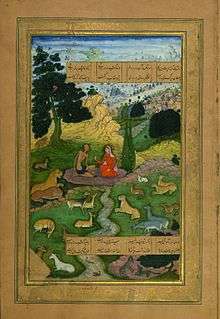
Qays ibn al-Mullawah fell in love with Layla al-Aamiriya. He soon began composing poems about his love for her, mentioning her name often. His unselfconscious efforts to woo the girl caused some locals to call him "Majnun." When he asked for her hand in marriage, her father refused because it would be a scandal for Layla to marry someone considered mentally unbalanced. Soon after, Layla was married to another noble and rich merchant belonging to the Thaqif tribe in Ta'if. He was described as a handsome man with reddish complexion whose name was Ward Althaqafi. The Arabs called him Ward, meaning "rose" in Arabic.
When Majnun heard of her marriage, he fled the tribal camp and began wandering the surrounding desert. His family eventually gave up hope for his return and left food for him in the wilderness. He could sometimes be seen reciting poetry to himself or writing in the sand with a stick.
Layla is generally depicted as having moved to a place in Northern Arabia with her husband, where she became ill and eventually died. In some versions, Layla dies of heartbreak from not being able to see her would-be lover. Majnun was later found dead in the wilderness in 688 AD, near Layla's grave. He had carved three verses of poetry on a rock near the grave, which are the last three verses attributed to him.
Many other minor incidents happened between his madness and his death. Most of his recorded poetry was composed before his descent into madness.
I pass by this town, the town of Layla
And I kiss this wall and that wall
It’s not Love of the town that has enraptured my heart
But of the One who dwells within this town
It is a tragic story of undying love much like the later Romeo and Juliet. This type of love is known as "virgin love" because the lovers never marry or consummate their passion. Other famous virgin love stories set in Arabia are the stories of Qays and Lubna, Kuthair and Azza, Marwa and Al Majnoun Al Faransi, and Antara and Abla. This literary motif is common throughout the world, notably in the Muslim literature of South Asia, such as Urdu ghazals.
History and influence
Persian adaptation and Persian literature
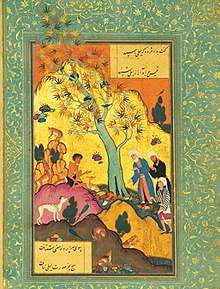
The story of Layla and Majnun was known in Persia as early as the 9th century. Two well known Persian poets, Rudaki and Baba Taher, both mention the lovers.[17][18]
Although the story was known in Arabic literature in the 5th century,[19] it was the Persian masterpiece of Nizami Ganjavi that popularized it dramatically in Persian literature. Nizami collected both secular and mystical sources about Majnun and portrayed a vivid picture of the famous lovers.[13] Subsequently, many other Persian poets imitated him and wrote their own versions of the romance.[13] Nizami drew influence from Udhrite love poetry, which is characterized by erotic abandon and attraction to the beloved, often by means of an unfulfillable longing.[14] Other influences include older Persian epics, such as Vāmiq u 'Adhrā, written in the 11th century, which covers a similar topic of a virgin and her passionate lover; the latter having to go through many trials to be with his love.[20]
In his adaptation, the young lovers become acquainted at school and fell desperately in love. However, they could not see each other due to a family feud, and Layla's family arranged for her to marry another man.[21] According to Dr. Rudolf Gelpke, "Many later poets have imitated Nizami's work, even if they could not equal and certainly not surpass it; Persians, Turks, Indians, to name only the most important ones. The Persian scholar Hekmat has listed no less than forty Persians and thirteen Turkish versions of Layli and Majnun."[22] According to Vahid Dastgerdi, "If one would search all existing libraries, one would probably find more than 1000 versions of Layli and Majnun."
In his statistical survey of famous Persian romances, Ḥasan Ḏulfaqāri enumerates 59 'imitations' (naẓiras) of Layla and Majnun as the most popular romance in the Iranian world, followed by 51 versions of Ḵosrow o Širin, 22 variants of Yusuf o Zuleikha and 16 versions of Vāmiq u ʿAḏhrā.[18]
Azerbaijani adaptation and Azerbaijani literature
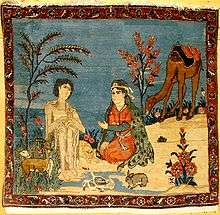
The story of Layla and Majnun passed into Azerbaijani literature. The Azerbaijani language adaptation of the story, Dâstân-ı Leylî vü Mecnûn (داستان ليلى و مجنون; "The Epic of Layla and Majnun") was written in the 16th century by Fuzûlî and Hagiri Tabrizi. Fuzûlî's version was borrowed by the renowned Azerbaijani composer Uzeyir Hajibeyov, who used the material to create what became the Middle East's first opera. It premiered in Baku on 25 January 1908. The story had previously been brought to the stage in the late 19th century, when Ahmed Shawqi wrote a poetic play about the tragedy, now considered one of the best in modern Arab poetry. Majnun lines from the play are sometimes confused with his actual poems.
A scene of the poem is depicted on the reverse of the Azerbaijani 100 and 50 manat commemorative coins minted in 1996 for the 500th anniversary of Fuzûlî's life and activities.[23]
Other influences
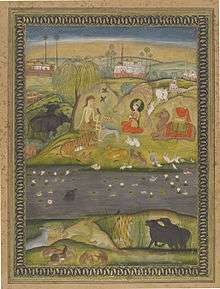
The enduring popularity of the legend has influenced Middle Eastern literature, especially Sufi writers, in whose literature the name Layla refers to their concept of the Beloved. The original story is featured in Bahá'u'lláh's mystical writings, the Seven Valleys. In Arabic language, Layla name means "night," and is thought to mean "one who works by night" or "worker of the dark." This is an apparent allusion to the fact that the romance of the star-crossed lovers was hidden and kept secret. In the Arabic language, the word Majnun means "a crazy person." In addition to this creative use of language, the tale has also made at least one linguistic contribution, inspiring a Turkish colloquialism: to "feel like Mecnun" is to feel completely possessed, as might be expected of a person who is literally madly in love.
This epic poem was translated into English by Isaac D'Israeli in the early 19th century allowing a wider audience to appreciate it.
Layla has also been mentioned in many works by Aleister Crowley in many of his religious texts, including The Book of Lies.
In India, it is believed that Layla and Majnun found refuge in a village in Rajasthan before they died. The graves of Layla and Majnun are believed to be located in the Bijnore village near Anupgarh in the Sriganganagar district. According to rural legend there, Layla and Majnun escaped to these parts and died there. Hundreds of newlyweds and lovers from India and Pakistan, despite there being no facilities for an overnight stay, attend the two-day fair in June.
Another variation on the tale tells of Layla and Majnun meeting in school. Majnun fell in love with Layla and was captivated by her. The school master would beat Majnun for paying attention to Layla instead of his school work. However, upon some sort of magic, whenever Majnun was beaten, Layla would bleed for his wounds. The families learnt of this strange magic and began to feud, preventing Layla and Majnun from seeing each other. They meet again later in their youth and Majnun wishes to marry Layla. Layla's brother, Tabrez, would not let her shame the family name by marrying Majnun. Tabrez and Majnun quarreled and, stricken with madness over Layla, Majnun murdered Tabrez. Word reached the village and Majnun was arrested. He was sentenced to be stoned to death by the villagers. Layla could not bear it and agreed to marry another man if Majnun would be kept safe from harm in exile. Her terms were accepted and Layla got married, but her heart still longed for Majnun. Hearing this, Layla's husband rode with his men into the desert to find Majnun. Upon finding him, Layla's husband challenged Majnun to the death. The instant her husband's sword pierced Majnun's heart, Layla collapsed in her home. Layla and Majnun were buried next to each other as her husband and their fathers prayed to their afterlife. Myth has it that Layla and Majnun met again in heaven, where they loved forever.
In popular culture
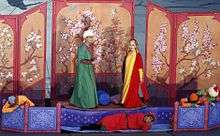
- In Humayun Ahmed's Noy Number Bipod Sanket, a song written by him and rendered by Meher Afroz Shaon, titled Laili-Mojnu, Shiri-Forhad...Radha-Krishna Ka Kahani Sunaunga(Today, I'm Going To) Tell (You) The Story of Laili (Layla) -Mojnu (Majnun), Shiri-Forhad...Radha-Krishna was used.
- In Cassandra Clare's Chain of Gold, half Persian character Cordelia Carstairs is nicknamed Layla as a term of endearment and to show her family's love of the story.
- In Roshani Chokshi's The Gilded Wolves, Laila calls Séverin “Majnun” meaning madman in reference to this poem.
- The tale and the name "Layla" served as Eric Clapton's inspiration for the title of Derek and the Dominos' famous album Layla and Other Assorted Love Songs and its title track in 1971. The song "I Am Yours" is a direct quote from a passage in Layla and Majnun.
- The tale was adapted as a play in Arabic, "Majnun Layla", by the Egyptian poet Ahmad Shawqi known also as the Prince of Poets in 1932.
- The tale served as the inspiration for Halim El-Dabh's early electronic tape music composition called Leiyla and the Poet in 1959.
- The tale of Layla and Majnun has been the subject of various films produced by the Indian film industry beginning in the 1920s. A list may be found here: http://www.thehindu.com/features/cinema/article419176.ece. One, Laila Majnu, was produced in 1976. In 2007, the story was enacted as both a framing story and as a dance-within-a-movie in the film Aaja Nachle. Also, in pre-independence India, the first Pashto-language film was an adaptation of this story.
- The term Layla-Majnun is often used for lovers, also Majnun is commonly used to address a person madly in love.
- Orhan Pamuk makes frequent reference to Leyla and Majnun in his novels, The Museum of Innocence and My Name is Red.
- One of the panels in the Alisher Navoi metro station in Tashkent (Uzbekistan) and Nizami Gəncəvi metro station in Baku (Azerbaijan) represents the epic on blue green tiles.
- In the book A Thousand Splendid Suns by Afghan author Khaled Hosseini, Rasheed often refers to Laila and Tariq as Layla and Majnun.
- South African Author Achmat Dangor of mixed Indian descent makes reference to Leyla and Majnun in his novels, "Waiting for Leila" and "Kafka's Curse"
- On Gaia Online, a recent monthly collectible released an item under the names Majnun and Layla loosely based on the story.
- Layla and Majnun — poem of Alisher Navoi.
- Layla and Majnun — poem of Jami.
- Layla and Majnun — poem of Nizami Ganjavi.
- Layla and Majnun — poem of Fuzûlî.
- Layla and Majnun — poem of Hagiri Tabrizi.
- Layla and Majnun — drama in verse of Mirza Hadi Ruswa.
- Layla and Majnun — novel of Necati.
- Leyli and Majnun — the first Muslim and the Azerbaijani opera of Uzeyir Hajibeyov (1908).
- Layla and Majnun — symphonic poem of Gara Garayev (1947).
- Leyli and Majnun — ballet by Gara Garayev (1969).
- Symphony No. 24 ("Majnun"), Op. 273 (1973), for tenor solo, trumpet, choir and strings – Alan Hovhaness.
- The Song of Majnun — opera of Bright Sheng (1992)
- Laila Majnu — Pakistani film in 1974 starring Waheed Murad and Rani
- Laila Majnu — Indian Hindi silent film in 1922.
- Laila Majnu — Indian Hindi silent film in 1927.
- Laila Majnu — Indian Hindi film in 1931.
- Laila Majnu — Indian Hindi film in 1931.
- Laila Majnun — Malayan Malay film in 1933.
- Layla and Majnun — Iranian film in 1936.
- Laila Majnu — Indian Telugu film in 1949.
- Layla and Majnun — Tajik Soviet film-ballet of 1960.
- Layla and Majnun — Soviet Azerbaijani film of 1961.
- Laila Majnu — Indian Malayalam film in 1962.
- Laila Majnu — Indian Hindi film in 1976.
- Laily Majnu — Bangladeshi film in 1976 starring Razzak and Babita.
- Leyla ile Mecnun — Music album of Orhan Gencebay in 1981.
- Leyla ile Mecnun — Turkish drama film in 1982.
- Love And God (1986) — Indian Hindi film directed by K. Asif
- Layla and Majnun — Azerbaijani film-opera of 1996.
- Aaja Nachle— a 2007 Indian film has a 15-minute musical play on life of Layla and Majnun.
- Majnoon Layla a 2010 song by Syrian-American hip-hop artist and peace activist Omar Offendum.
- Leyla ile Mecnun — is a Turkish television comedy series in 2011.
- Habibi (movie) — is a 2011 film by Susan Youssef filmed in the Gaza strip.
- Double Barrel — is a Malayalam Movie in 2015.
- Tamasha – is a Hindi movie of 2015. A musical story in this movie has parts of laila majnu duet.
- Laila The Musical – British theatre production by Rifco Arts, Watford Palace Theatre and Queen's Theatre Hornchurch toured England during 2016.[24]
- Layla and Majnun — dance-drama, a collaboration of Mark Morris, Silk Road Ensemble and Howard Hodgkin; 2016 premiere by Cal Performances.[25]
- Laila Majnu – is a 2018 Hindi movie based on the legend of Laila Majnu set in Kashmir.
See also
| Wikimedia Commons has media related to Layla and Majnun. |
- Muna Madan
- Heer Ranjha
- Sassui Punhun
- Tomb paintings of Sindh
Notes
- Nizami's tragic romance Khosrow and Shirin is another part of the Khamsa.
References
- Banipal: Magazine of Modern Arab Literature.
- Schimmel, Annemarie (2014). A Two-Colored Brocade: The Imagery of Persian Poetry. p. 131.
Indeed, the old Arabic love story of Majnun and Layla became a favorite topic among Persian poets.
- The Islamic Review & Arab Affairs. 58. 1970. p. 32.
Nizāmī's next poem was an even more popular lovestory of the Islamic world, Layla and Majnun, of Arabic origin.
- electricpulp.com. "LEYLI O MAJNUN – Encyclopaedia Iranica". www.iranicaonline.org. Retrieved 14 March 2018.
- The Posthumous career of Manuel Puig. 1991. p. 758.
- Bruijn, J. T. P. de; Yarshater, Ehsan (2009). General Introduction to Persian Literature: A History of Persian Literature. I. B. Tauris. ISBN 9781845118860.
- PhD, Evans Lansing Smith; Brown, Nathan Robert (2008). The Complete Idiot's Guide to World Mythology. Penguin. ISBN 9781101047163.
- Grose, Anouschka (2011). No More Silly Love Songs: A Realist's Guide To Romance. Granta Publications. ISBN 9781846273544.
- "Archived copy". Archived from the original on 8 July 2017. Retrieved 2 March 2017.CS1 maint: archived copy as title (link)
- al-hakawati.net/arabic/Civilizations/diwanindex2a4.pdf
- http://www.visions.az/en/news/271/a3e8bd5c/
- Byron (1814), The Giaour, a fragment of a Turkish tale, London Printed by T. Davison for J. Murray, p. 61
- Layli and Majnun: Love, Madness and Mystic Longing, Dr. Ali Asghar Seyed-Gohrab, Brill Studies in Middle Eastern literature, Jun 2003, ISBN 90-04-12942-1. excerpt:Although Majnun was to some extent a popular figure before Nizami’s time, his popularity increased dramatically after the appearance of Nizami’s romance. By collecting information from both secular and mystical sources about Majnun, Nizami portrayed such a vivid picture of this legendary lover that all subsequent poets were inspired by him, many of them imitated him and wrote their own versions of the romance. As we shall see in the following chapters, the poet uses various characteristics deriving from ‘Udhrite love poetry and weaves them into his own Persian culture>. In other words, Nizami Persianises the poem by adding several techniques borrowed from the Persian epic tradition, such as the portrayal of characters, the relationship between characters, description of time and setting, etc.
- Scroggins, Mark (1996). "Review". African American Review. doi:10.2307/3042384. JSTOR 3042384.
- Seyed-Gohrab, A. A. (15 July 2009). "LEYLI O MAJNUN". Encyclopædia Iranica. Retrieved 7 July 2012.
- Badawi, M.M. (1987). Modern Arabic Drama in Egypt. p. 225.
- •Zanjani, Barat. "Layla va Majnun-I Nizami Ganjavi: matn-I Ilmi va intiqadi az ru-yi qadimtari nuskha-hayi khatti-I qarn-I hashtum ba zikr-i ikhtilaf-i nusakh va ma’ani lughat va tarikbat va kashf al-bayat", Tehran, Mu’assasah-I Chap va Intisharat-I Danishgah Tehran, 1369[1990] Rudaki: مشوش است دلم از کرشمهی سلمی چنان که خاطره ی مجنون ز طره ی لیلی
- A. A. Seyed-Gohrab, "LEYLI O MAJNUN" in Encyclopedia Iranica
- Waheib, Osama. "Arabic Literature: The Immortal Love Story of Qays and Layla". ArabiCollege. Retrieved 20 August 2018.
- T. Hägg, B. Utas (2003). The Virgin and Her Lover: Fragments of an Ancient Greek Novel and a Persian Epic Poem. BRILL. ISBN 9789004132603.
- ArtArena: "Layli and Madjnun in Persian Literature"
- The Story of Layla and Majnun, by Nizami. Translated Dr. Rudolf. Gelpke in collaboration with E. Mattin and G. Hill, Omega Publications, 1966, ISBN 0-930872-52-5.
- Central Bank of Azerbaijan. Commemorative coins. Coins produced within 1992–2010 Archived 19 January 2010 at the Wayback Machine: Gold and silver coins dedicated to memory of Mahammad Fuzuli. – Retrieved on 25 February 2010.
- "Laila – The Musical". RIFCO Arts. 2016.
- Macaulay, Alistair (2 October 2016). "From Mark Morris, a Tale of Love Refracted and Multiplied". The New York Times. Retrieved 9 March 2018.
Further reading
- Nizami, The Story of Layla & Majpoonun, ISBN 0-930872-52-5
- Nizami and Colin Turner, Layla and Majnun, ISBN 1-85782-161-0
External links
- LEYLI O MAJNUN in Encyclopædia Iranica A. A. Seyed-Gohrab (accessed September 2010 – periodically check link)
- Laila and Majnun at School: Page from a manuscript of the Laila and Majnun of Nizami
- Part of Ahmad Shawqi's opera Majnun Layla, sung by Mohammed Abdelwahab and Asmahan (accessed 22 October 2017)
